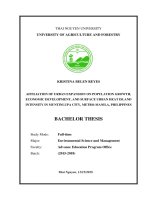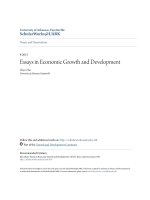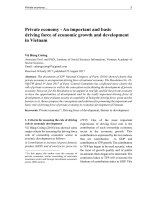Economic growth and economic development 452
Bạn đang xem bản rút gọn của tài liệu. Xem và tải ngay bản đầy đủ của tài liệu tại đây (127.33 KB, 1 trang )
Introduction to Modern Economic Growth
subject to
(9.23)
ci (t) + bi (t) ≤ yi (t) ≡ w (t) + R (t) bi (t − 1) ,
where yi (t) denotes the income of this individual,
(9.24)
w (t) = f (k (t)) − k (t) f 0 (k (t))
is the equilibrium wage rate,
(9.25)
R (t) = f 0 (k (t))
is the rate of return on capital and bi (t − 1) is the bequest received by this individual
from his own parent.
The total capital-labor ratio at time t + 1 is given by aggregating the bequests
of all adults at time t:
(9.26)
k (t + 1) =
Z
1
bi (t) di,
0
which exploits the fact that the total measure of workers is 1, so that the capital
stock and capital-labor ratio are identical.
An equilibrium in this economy is a somewhat more complicated object than
before, because we may want to keep track of the consumption and bequest levels
of all individuals. Let us denote the distribution of consumption and bequests
across households at time t by [ci (t)]i∈[0,1] and [bi (t)]i∈[0,1] , and let us assume that
the economy starts with the distribution of wealth (bequests) at time t given by
R1
[bi (0)]i∈[0,1] , which satisfies 0 bi (0) di > 0.
Definition 9.2. An equilibrium in this overlapping generations economy with
warm glow npreferences is a sequence
o∞of consumption and bequest levels for each
, that solve (9.22) subject to (9.23), a sehousehold, [ci (t)]i∈[0,1] , [bi (t)]i∈[0,1]
t=0
quence of capital-labor ratios, {k (t)}∞
t=0 , given by (9.26) with some initial distribution of bequests [bi (0)]i∈[0,1] , and sequences of factor prices, {w (t) , R (t)}∞
t=0 , that
satisfy (9.24) and (9.25).
438









